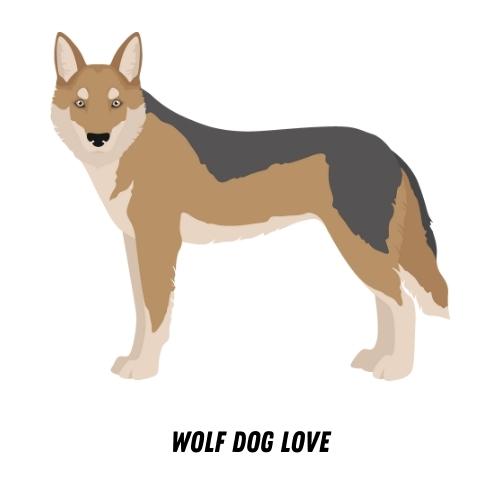Introduction to Wolf Dog Breeds
Wolf dog breeds are a fascinating topic, combining the allure of the wild with the familiarity of our beloved canine companions. This introduction will help you understand the concept of wolf dog breeds and explore their history and evolution.
- Understanding the concept of Wolf Dog Breeds
Wolf dog breeds, also known as wolf hybrids, are a unique group of dogs that have a wolf in their recent ancestry. They are not pure wolves, but rather a mix of a domestic dog and a wolf. This combination results in an animal that has traits of both its wolf and dog parents.
Wolf dogs can vary greatly in appearance, behavior, and temperament, depending on the breeds involved and the percentage of wolf genes they possess. Some wolf dogs may look very much like a wolf, while others may have more of the physical characteristics of their dog parent.
- History and evolution of Wolf Dog Breeds
The history of wolf dog breeds is as intriguing as the breeds themselves. The first known wolf dog breeds were likely the result of unintentional breeding between wolves and dogs living in close proximity to each other. However, intentional breeding of wolf dogs has been taking place for several centuries.
Historically, wolf dogs were often bred for specific purposes, such as hunting or guarding. In more recent times, they have also been bred for their unique appearance and as a way for people to feel a closer connection to the wild.
Over time, these breeds have evolved, with breeders selecting for specific traits and characteristics. This has resulted in a wide variety of wolf dog breeds, each with its own unique blend of wolf and dog traits.
Understanding the concept and history of wolf dog breeds is the first step in appreciating these unique and fascinating animals. As we delve deeper into this topic, we will explore the diversity of wolf dog breeds, the science behind them, and celebrate their differences.
Celebrating Dog Diversity: An Overview of Wolf Dog Varieties
Wolf dogs, a unique blend of domestic dog and wild wolf, are a testament to the incredible diversity of the canine world. These fascinating creatures come in a variety of breeds, each with its own unique characteristics and traits. Let’s take a closer look at some of the most popular wolf dog breeds.
Different Types of Wolf Dogs: A Closer Look
- Alaskan Malamute
- Siberian Husky
- German Shepherd
- Others
The Alaskan Malamute is a large breed of domestic dog known for its strength and endurance. Originally bred for hauling heavy freight, they are also well-suited to work in packs. With a wolf-like appearance, they are often mistaken for wolf dogs. However, they are purebred dogs with no recent wolf ancestry.
Siberian Huskies are known for their striking appearance, which closely resembles that of wolves. They were originally bred by the Chukchi people for sled pulling, herding, and companionship. Despite their wolf-like features, Siberian Huskies are friendly and gentle with a strong desire to run.
German Shepherds are one of the most popular breeds worldwide, known for their intelligence and versatility. They are often used in police and military roles because of their trainability and obedience. While not a wolf dog, some German Shepherds can have a wolf-like appearance due to their size and coat color.
There are many other breeds and mixed breeds that can have wolf-like characteristics, including the Czechoslovakian Wolfdog and the Saarloos Wolfdog. These breeds were created by crossing domestic dogs with wolves to create a unique blend of wild and domestic traits.
In conclusion, while there are many breeds that resemble wolves, it’s important to remember that true wolf dogs are a blend of domestic dog and wild wolf. These unique creatures are a testament to the incredible diversity of the canine world.
Understanding Wolf Dog Breeds: The Science Behind the Breeds
Wolf dog breeds are a fascinating blend of domestic dog and wild wolf. Understanding these unique animals requires a closer look at their genetic makeup, physical characteristics, and behavioral patterns. Let’s delve into the science behind these breeds.
-
Genetic Makeup of Wolf Dog Breeds
Wolf dogs are a hybrid breed, a mix between a domestic dog and a wild wolf. Their genetic makeup is a blend of both species. Scientists use DNA testing to determine the percentage of wolf and dog genes in a wolf dog. For instance, a wolf dog could be 75% wolf and 25% dog, or vice versa. This genetic mix contributes to their unique traits and behaviors.
-
Physical Characteristics and Traits
Wolf dogs often have a physical appearance that reflects their wild ancestry. They usually have a larger body size, longer legs, and a more robust build compared to most domestic dogs. Their coat colors can vary, but common shades include gray, brown, black, and white. Their eyes can be amber, brown, or, in rare cases, blue. However, the physical traits can vary widely among individual wolf dogs due to their mixed genetic makeup.
-
Behavioral Patterns and Temperaments
Wolf dogs exhibit a range of behaviors that reflect both their domestic and wild heritage. They are often intelligent, independent, and have a strong prey drive. They can be wary of strangers and may require extensive socialization. Some wolf dogs may exhibit more dog-like behaviors, while others may act more like a wolf. It’s important to remember that each wolf dog is unique and their behaviors can vary greatly.
In conclusion, wolf dogs are a unique blend of domestic dog and wild wolf. Their genetic makeup, physical traits, and behaviors reflect this mix. Understanding these aspects can help us appreciate the diversity and uniqueness of these fascinating animals.
Wolf Dog Breed Diversity: Celebrating the Differences
Wolf dog breeds are a fascinating mix of domestic dog and wild wolf traits. Each breed is unique, offering a different blend of characteristics that make them special. Let’s celebrate the diversity of these breeds by comparing them in detail.
Case Study: Comparing Different Wolf Dog Breeds
By comparing different wolf dog breeds, we can better appreciate their individual strengths and characteristics. We will focus on two case studies: Alaskan Malamute vs Siberian Husky and German Shepherd vs Alaskan Malamute.
- Case Study 1: Alaskan Malamute vs Siberian Husky
- Case Study 2: German Shepherd vs Alaskan Malamute
Both the Alaskan Malamute and Siberian Husky have their roots in the Arctic and are known for their strength and endurance. However, there are some key differences between them.
| Characteristics | Alaskan Malamute | Siberian Husky |
|---|---|---|
| Size | Larger, up to 85 pounds | Smaller, up to 60 pounds |
| Temperament | Friendly, but can be stubborn | Outgoing, but can be mischievous |
| Exercise Needs | High | High |
The German Shepherd and Alaskan Malamute are both intelligent and hardworking breeds, but they have different temperaments and physical characteristics.
| Characteristics | German Shepherd | Alaskan Malamute |
|---|---|---|
| Size | Large, up to 90 pounds | Larger, up to 85 pounds |
| Temperament | Loyal and protective | Friendly, but can be stubborn |
| Exercise Needs | High | High |
In conclusion, each wolf dog breed offers a unique set of traits and characteristics. By understanding these differences, we can better appreciate the diversity and richness of these breeds.
Celebrating Wolf Dog Breeds: Embracing the Spectrum
When it comes to wolf dog breeds, there’s a whole spectrum to celebrate. These unique and captivating canines offer a diverse range of traits, characteristics, and personalities that make each breed truly special. Let’s explore the importance of this breed diversity and how it plays a crucial role in canine health.
- Importance of Breed Diversity
Breed diversity is essential in the world of wolf dogs. It’s not just about having a variety of breeds for pet lovers to choose from. It’s about preserving the rich genetic heritage of these remarkable animals. Each breed has its own unique set of traits and characteristics, which contribute to the overall diversity of the canine species.
When we celebrate breed diversity, we’re acknowledging the importance of genetic variation. This variation is what allows wolf dogs to adapt to different environments and challenges. It’s what makes each breed unique and special. So, when we embrace the spectrum of wolf dog breeds, we’re not just celebrating the differences between breeds, but also the richness and complexity of canine genetics.
- Role of Breed Diversity in Canine Health
Breed diversity plays a vital role in canine health. A diverse gene pool can help to protect against certain health issues that can affect wolf dogs. For example, some breeds are more susceptible to certain diseases than others. By maintaining a diverse gene pool, we can help to ensure that these breeds have the best possible chance of survival.
Moreover, breed diversity can also contribute to the overall health and vitality of the canine species. Diverse genes can lead to healthier, stronger dogs with a greater ability to adapt to different environments and challenges. So, by celebrating and preserving breed diversity, we’re not just ensuring the survival of individual breeds, but also contributing to the overall health and wellbeing of the canine species.
In conclusion, the spectrum of wolf dog breeds is something to be celebrated. It’s a testament to the richness and diversity of the canine species. By embracing this diversity, we’re not just acknowledging the unique traits and characteristics of each breed, but also the vital role that this diversity plays in canine health.
Wolf Dog Breed Varieties: A Glimpse into the World of Hybrid Breeds
As we continue our journey into the fascinating world of wolf dog breeds, let’s take a moment to explore hybrid breeds. These unique breeds are a blend of domestic dog and wolf, resulting in a pet with a unique set of characteristics and behaviors.
Understanding Hybrid Wolf Dog Breeds
Hybrid wolf dog breeds are a fascinating topic. They are a mix of domestic dog and wolf, creating a unique breed that is both familiar and exotic. Let’s delve deeper into what these breeds are and some popular examples of them.
- What are hybrid breeds?
- Popular hybrid wolf dog breeds
Hybrid breeds are a result of crossbreeding between two different species or subspecies. In the case of wolf dog breeds, this involves breeding a domestic dog with a wolf. The result is a hybrid that carries traits from both parents. These can include physical characteristics, behaviors, and even health issues. Hybrid breeds are often bred for specific purposes, such as hunting or guarding, but they can also make unique and interesting pets.
There are many popular hybrid wolf dog breeds. Here are a few examples:
| Breed | Description |
|---|---|
| Wolamute | A cross between an Alaskan Malamute and a Timber Wolf, known for their strength and endurance. |
| Saarloos Wolfdog | Bred by crossing a German Shepherd with a Eurasian Wolf, these dogs are known for their loyalty and protective nature. |
| Czechoslovakian Wolfdog | Created by crossing a German Shepherd with a Carpathian Wolf, these dogs are intelligent and highly trainable. |
These are just a few examples of the many hybrid wolf dog breeds out there. Each one has its own unique set of traits and characteristics, making them a fascinating topic for any dog lover.
As we continue to explore the world of wolf dog breeds, remember that each breed is unique and has its own set of needs and requirements. Always do your research before bringing a new pet into your home.
Diversity in Wolf Dog Breeds: A Celebration of Uniqueness
Wolf dog breeds are as diverse as they are fascinating. Each breed carries a unique blend of traits, characteristics, and behaviors that make them stand out. This diversity is not just about physical differences, but also about the rich tapestry of personalities, temperaments, and abilities that these breeds bring to the table. Let’s celebrate this uniqueness and delve into the key takeaways on the diversity of wolf dog breeds.
- Key takeaways on the diversity of wolf dog breeds
Wolf dog breeds are a result of careful and selective breeding between wolves and dogs. This has resulted in a wide range of breeds, each with their own unique characteristics. Here are some key points to remember:
| Breed | Unique Traits |
|---|---|
| Alaskan Malamute | Known for their strength and endurance, these dogs are excellent sled pullers. |
| Siberian Husky | These dogs are known for their striking blue or multicolored eyes and their ability to withstand cold temperatures. |
| Czechoslovakian Wolfdog | A breed that closely resembles a wolf in appearance and behavior, but with the temperament of a dog. |
These are just a few examples of the diversity in wolf dog breeds. Each breed brings something unique to the table, making them a wonderful addition to any family.
- Final thoughts on celebrating wolf dog breeds
Wolf dog breeds are a testament to the beauty of diversity. Each breed, with its unique traits and characteristics, contributes to the rich tapestry of the canine world. Celebrating these breeds is about appreciating the differences, understanding the unique needs and behaviors of each breed, and providing them with the love and care they deserve.
As we celebrate the diversity in wolf dog breeds, let’s remember that each breed is unique and special in its own way. Let’s celebrate their uniqueness, their strength, their spirit, and their ability to bring joy and companionship into our lives.








